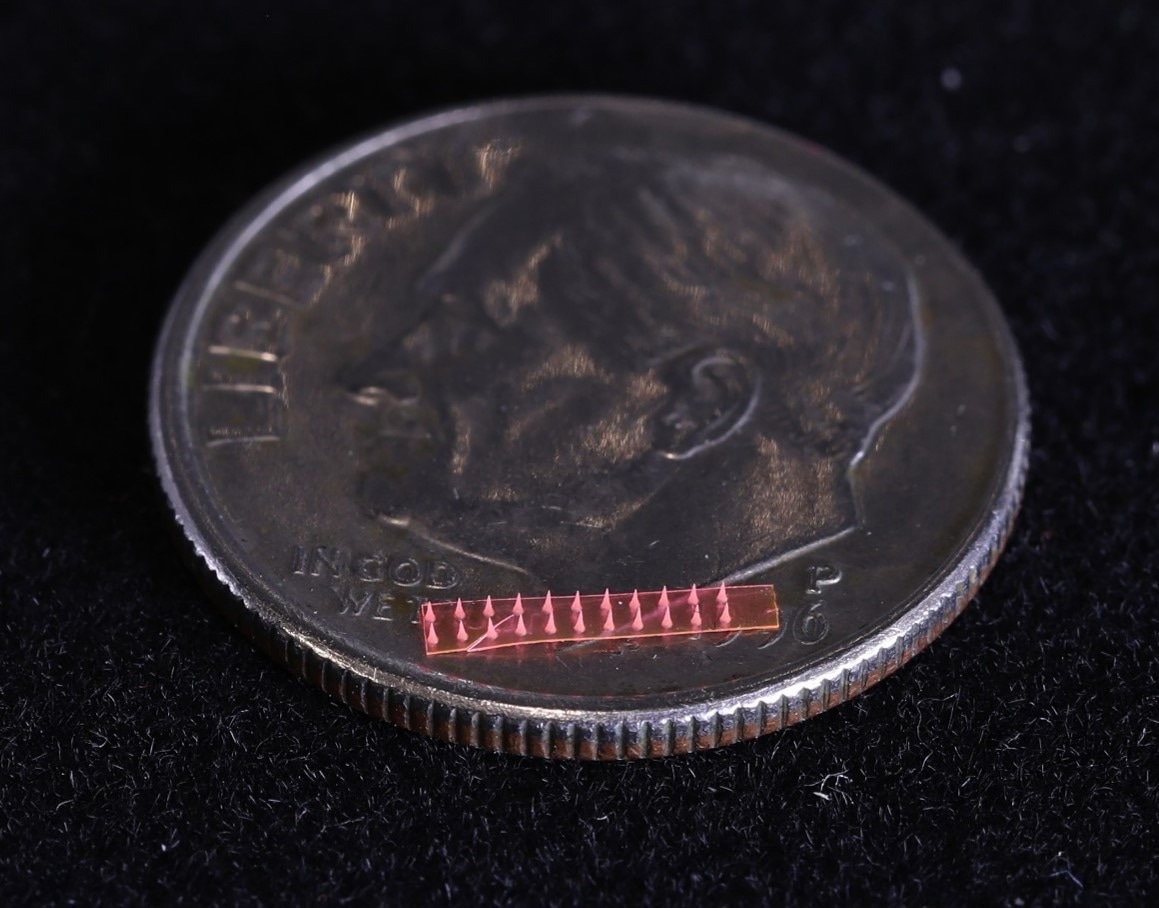Researchers from the Disruptive & Sustainable Technologies for Agricultural Precision (DiSTAP) Interdisciplinary Research Group (IRG) of Singapore-MIT Alliance for Research and Technology (SMART), MIT’s research enterprise in Singapore, and their collaborators from Temasek Life Sciences Laboratory (TLL) and Massachusetts Institute of Technology (MIT), have developed the first-ever microneedle-based drug delivery technique for plants. The method can be used to precisely deliver controlled amounts of agrochemicals to specific plant tissues for research purposes. When applied in the field, it could be used in precision agriculture to improve crop quality and disease management.
 Illustration of a silk microneedle array on a dime coin. Image Credit: Singapore-MIT Alliance for Research and Technology (SMART)
Illustration of a silk microneedle array on a dime coin. Image Credit: Singapore-MIT Alliance for Research and Technology (SMART)
Increasing environmental conditions caused by climate change, an ever-growing human population, scarcity of arable land, and limited resources are pressuring the agriculture industry to adopt more sustainable and precise practices that foster more efficient use of resources (e.g. water, fertilisers, and pesticides) and mitigation of environmental impacts. Developing delivery systems that efficiently deploy agrochemicals such as micronutrients, pesticides, and antibiotics in crops will help ensure high productivity and high produce quality while minimising the waste of resources is crucial.
However, current and standard practices for agrochemical application in plants, such as foliar spray, are inefficient due to off-target application, quick run-off in the rain, and actives’ rapid degradation. These practices also cause significant detrimental environmental side effects, such as water and soil contamination, biodiversity loss and degraded ecosystems; and public health concerns, such as respiratory problems, chemical exposure and food contamination.
The novel silk-based microneedles technique developed by SMART circumvents these limitations by deploying and targeting a known amount of payload directly into a plant’s deep tissues, which will lead to higher efficacy of plant growth and help with disease management. The technique is minimally invasive as it delivers the compound without causing long-term damage to the plants and is environmentally sustainable. It minimises resource wastage and mitigates the adverse side effects caused by agrochemical contamination of the environment. Additionally, it will help foster precise agricultural practices and provide new tools to study plants and design crop traits, helping to ensure food security.
Described in a paper titled “Drug Delivery in Plants Using Silk Microneedles”, published in the January 2023 issue of Advanced Materials, the research studies the first-ever polymeric microneedles used to deliver small compounds to a wide variety of plants and the plant response to biomaterial injection. Through gene expression analysis, the researchers could closely examine the reactions to drug delivery following microneedle injection. Minimal scar and callus formation were observed, suggesting minimal injection-induced wounding to the plant. The proof-of-concept provided in this study opens the door to plant microneedles’ application in plant biology and agriculture, enabling new means to regulate plant physiology and study metabolisms via efficient and effective delivery of payloads.
The study optimised the design of microneedles to target the systemic transport system in Arabidopsis (mouse-ear cress), the chosen model plant. Gibberellic acid (GA3), a widely used plant growth regulator in agriculture, was selected for the delivery. The researchers found that delivering GA3 through microneedles was more effective in promoting growth than traditional methods (such as foliar spray). They then confirmed the effectiveness using genetic methods and demonstrated that the technique is applicable to various plant species, including vegetables, cereals, soybean and rice.
Professor Benedetto Marelli, co-corresponding author of the paper, Principal Investigator at DiSTAP, and Associate Professor of Civil and Environmental Engineering at MIT, shared, “The technique saves resources as compared to current methods of agrochemical delivery, which suffer from wastage. During the application, the microneedles break through the tissue barriers and release compounds directly inside the plants, avoiding agrochemical losses. The technique also allows for precise control of the amounts of the agrochemical used, ensuring high-tech precision agriculture and crop growth to optimise yield.”
The first-of-its-kind technique is revolutionary for the agriculture industry. It also minimises resource wastage and environmental contamination. In the future, with automated microneedle application as a possibility, the technique may be used in high-tech outdoor and indoor farms for precise agrochemical delivery and disease management.”
Dr Yunteng Cao, First Author of the Paper and Postdoctoral Associate of Civil and Environmental Engineering, MIT.
“This work also highlights the importance of using genetic tools to study plant responses to biomaterials. Analysing these responses at the genetic level offers a comprehensive understanding of these responses, thereby serving as a guide for the development of future biomaterials that can be used across the AgriFood industry,” said Sally Koh, the co-first author of this work and PhD candidate from the National University of Singapore (NUS) and TLL.
The future seems promising as Professor Daisuke Urano, co-corresponding author of the paper, TLL Principal Investigator and NUS Adjunct Assistant Professor elaborated, “Our research has validated the use of silk-based microneedles for agrochemical application, and we look forward to further developing the technique and microneedle design into a scalable model for manufacturing and commercialisation. At the same time, we are also actively investigating potential applications that could have a significant impact on society.”
The study of drug delivery in plants using silk microneedles expanded upon previous research supervised by Prof. Benedetto Marelli at MIT. The original idea was conceived by SMART and MIT: Prof. Marelli, Prof. Nam-Hai Chua, Co-Lead Principal Investigator at DiSTAP and Dr Yunteng Cao. Researchers from TLL and NUS, Prof. Urano Daisuke and Sally Koh, joined the study to contribute biological perspectives. The research is carried out by SMART and supported by NRF under its Campus for Research Excellence And Technological Enterprise (CREATE) programme.
Source: http://smart.mit.edu/